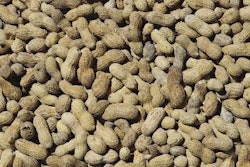Production losses and deaths from heat stress still plague the livestock industry despite many years of research. This fact suggests that our understanding of the problem still may be incomplete. The current paradigm held by animal scientists maintains that decreased production during heat stress is a direct result of an attempt by the animal to decrease its heat load. To lower its heat load, the paradigm maintains, the animal reduces feed intake. The paradigm also maintains that heat stroke is a consequence of heat-induced damage to the brain or dehydration-induced circulatory failure.
Consequently, nutritional strategies for reducing the negative effects of heat stress have been directed at the development of diets that have low heat increments. That is, these diets seek to generate less heat associated with the digestion and metabolism of nutrients. Thus, diets containing elevated dietary fat content have been advocated for hot conditions because the heat increment of fat is lower than that of any other nutrient. However, several reviews of trials involving the feeding of high-fat diets during heat stress have concluded that evidence for the efficacy of this strategy is inconsistent.
Furthermore, the lag between a heat episode and resumption of normal levels of feed intake, and the lag between heat waves and death of animals from heat stroke, suggest that the current paradigm for heat-induced production losses is too simplistic. Similarly, many aspects of the pathology of heat stroke in animals cannot be explained by damage to the brain or circulatory failure. Similar inconsistencies in the conventional explanation for heat stroke in humans have resulted in the adoption of a new paradigm by medical researchers. This paradigm places heat-induced damage to the gut at the centre of a cascade of events that result in multiple organ failure (Bouchama and Knochel, 2002).
A new paradigm of heat stress
Exposure of mammals to a high ambient temperature results in redirection of blood from the core of the body to the periphery to facilitate dissipation of body heat to the environment. In order to maintain blood pressure, the increased blood flow to the skin is counterbalanced by reduced blood flow to the gut. Gut cells can tolerate a lack of nutrients and oxygen for a limited time, but if deprivation is sustained, as would occur during a heat wave, the lining of the gut is damaged.
Under normal conditions, cells lining the gut are joined tightly together, which prevents foreign proteins from entering the body. The gut and liver are also equipped with a diverse complement of immune cells to destroy any potentially harmful molecules that enter the bloodstream. One of the most virulent foreign molecules is endotoxin, which is produced by bacteria such as E coli and Salmonella species that inhabit the gut of humans and livestock. Less than one millionth of a gram of endotoxin is sufficient to induce an acute immune response in humans.
The effects of endotoxin include fever, blood coagulation, decreased blood pressure, multiple organ failure, and death, all of which are consistent with the pathology of heat stroke. Endotoxin also causes severe depression of food intake, which is consistent with the effects of heat stress in livestock. In all species, there is a lag period between entry of endotoxin to the body and the appearance of symptoms, which provides an attractive explanation for why feed intake of livestock is depressed for several days after exposure to heat and why deaths of feedlot cattle often occur several days after a heat wave.
The critical role of the gut in heat stress has been validated by many experimental studies showing that exposure to heat stress impairs function of the lining of the gut. Other studies have detected elevated concentrations of endotoxin in heat-stressed monkeys, dogs, rats, humans, and even in marathon runners. A comprehensive review of the evidence for this new paradigm concluded that it is consistent with the effects of heat stress in livestock and provides a better explanation for the pathology of heat stroke in livestock than the current paradigm (Cronjé, 2005).
Dietary additives that improve gut integrity and health could make a substantial contribution to reducing the negative economic impact of heat stress in the livestock industry. Such a dietary strategy is supported by comprehensive evidence of diet-induced damage to the gut of all livestock species.
Diet-induced damage to the gut
Energy-dense production diets can have damaging effects on gut integrity and health in livestock. The magnitude of the damage is not widely appreciated as few producers are confronted with direct evidence of these lesions. However, abattoir surveys show that 90% of pigs slaughtered have lesions of the gut and that this is caused by finely processed and pelleted feeds (Friendship, 2005). Twenty-two percent of feedlot cattle slaughtered have liver abscesses (Smith, 1998), which are caused by entry of endotoxins and bacteria through a damaged rumen wall (Owens et al, 1998). In dairy cattle, laminitis is a direct consequence of the entry of toxins through a damaged gut and makes a major contribution to lameness, the incidence of which has been estimated at 55% (Clarkson et al, 1996). A common feature of all these cases of gut damage is the consumption of large amounts of highly-digestible or processed grain.
In the gut, harmful molecules such as endotoxin are excluded from entry to the blood on the basis of their size. Ingested sources of potential nutrients typically consist of long chains of molecules which, in their native state, are too large to pass into the gut cells. The function of digestive enzymes is to break these molecules down to components that are small enough to be transported into the gut cells.
However, when a small number of large compounds in the gut are converted into a greater number of smaller constituent molecules, the total concentration of dissolved molecules increases in osmolarity, which exceeds that of the gut cells. Because water flows from solutions of low osmolarity to those of high osmolarity, the digestion of food is accompanied by movement of water out of the blood into the gut. As nutrients are absorbed, the osmolarity of the gut decreases and that inside the gut cells increases, causing water to flow from the gut back into the blood.
Production diets for livestock contain high concentrations of feedstuffs that have been processed to increase the rate and extent of digestion. Digestion of these processed feedstuffs can increase the osmolarity of the gut contents to such an extent that the osmotic pressure of water moving from the blood into the digesta can damage the junctions between the cells lining the gut.
For example, in ruminants fed concentrate diets, the osmolarity of the rumen digesta can double within a short time. The force of the resulting osmotic pressure is sufficient to separate the surface layers of the rumen epithelium from the underlying layers and pull patches of the rumen epithelium into the rumen (Owens et al, 1998). The resulting gut lesions allow the entry of toxins and can cause direct economic consequences, including impaired growth rate and lower milk production. Also, such lesions may predispose livestock to heat-induced damage to the gut and thus to heat stress.
It is impractical to reduce the concentration or availability of dietary nutrients, but there are other ways in which to improve the ability of gut cells to cope with osmotic challenges. Of these, dietary betaine supplementation appears to offer the most practical and affordable solution.
Prevention of diet-induced gut damage
Organisms that are exposed to extreme osmotic challenges, such as marine invertebrates, plants that grow in saline environments, and bacteria, make use of organic osmolytes to reduce osmotic pressure. Dietary sources of organic osmolytes such as betaine are absorbed by the gut cells of mammals when the osmolarity of fluid outside the cells increases.
In recent research, a mixture of osmolytes, which included betaine, increased the resilience of cells to osmotic stress by 42% (Moeckel et al, 2002). Other research showed that gut tissues of poultry supplemented with betaine (Betafin® from Danisco Animal Nutrition) were better able to cope with an osmotic challenge than those of unsupplemented birds (Kettunen et al, 2001a, 2001b). Dietary betaine supplementation also improved the structure of the gut lining in poultry (Kettunen et al, 2001c) and increased nutrient absorption in poultry and pigs (reviewed by Eklund et al, 2005). In poultry, betaine supplementation reduced the invasiveness of coccidia, decreased the incidence of coccidia-related gut lesions, attenuated the decrease in gut villus height associated with coccidiosis, and enhanced the destruction of coccidia by the immune cells of the gut (Augustine et al, 1997; Augustine and Danforth, 1999; Kettunen et al, 2001c; Klasing et al, 2002).
Thus, the positive effects of betaine on gut integrity and health indicate that it could play a role in decreasing the susceptibility to heat-induced gut damage of livestock fed diets containing high levels of processed grains.
Prevention of heat-induced gut damage
The reduction in blood flow to the gut that accompanies heat stress damages cells because of an insufficient supply of energy. In cattle, half the energy consumption of the intestines is used on ion-pumps that maintain osmotic balance. Research has shown that betaine results in a 64% sparing of ion-pump activity (Moeckel et al, 2002). It is thus possible that betaine supplementation would enable gut cells to cope to a greater extent with the reduction in energy supply that accompanies heat stress. In the absence of heat stress, the energy-sparing effect of betaine on gut cells is equivalent to about 8% of whole-body energy requirements, which is in agreement with other research, which showed that the energy requirements of betaine-supplemented pigs were reduced by 5.5% (Schrama et al, 2003).
Many of the harmful effects of endotoxin are mediated by tumor necrosis factor- and nitric oxide. Researchers have reported that betaine decreased liver damage caused by endotoxin and reduced the secretion of tumor necrosis factor- by 38% and that of nitric oxide by 21% (Kim and Kim, 2002). A similar suppression of tumor necrosis factor- by a mixture of betaine and taurine was observed when liver cells were exposed to an osmotic challenge (Wettstein and Häussinger, 1997). These results suggest that betaine not only protects against gut damage, but enables the liver to cope when gut damage occurs.
In the new paradigm, the gut is a critical mediator of the adverse effects of heat stress and heat stroke, which presents exciting new opportunities for the livestock industry. Of these, dietary betaine supplementation has the potential not only to help prevent heat-induced damage to the gut, but to increase resilience against heat stress by decreasing diet-induced damage to the gut.
A full list of references is available from Danisco Animal Nutrition. Please contact [email protected], using the subject line 'Fighting heat stress'.















